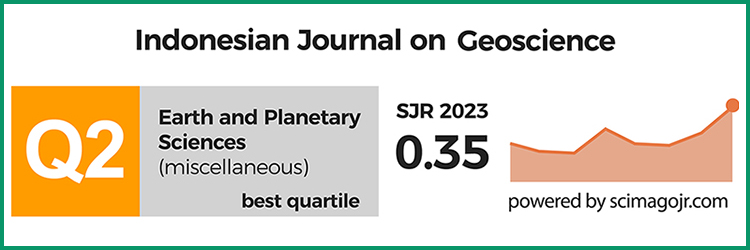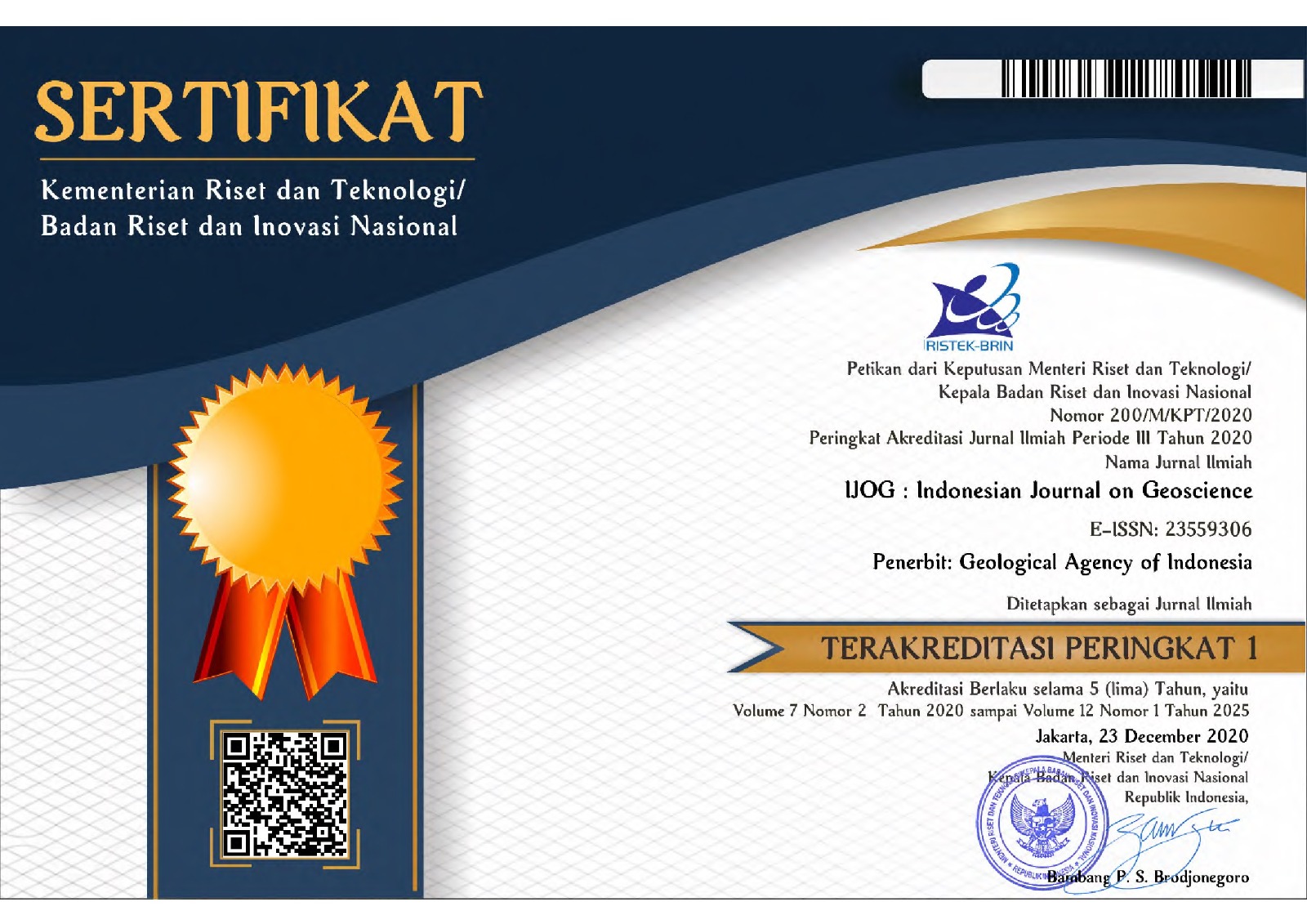Petrographic Characteristics and Depositional Environment Evolution of Middle Miocene Sediments in the Thien Ung - Mang Cau Structure of Nam Con Son Basin
DOI:
https://doi.org/10.17014/ijog.4.3.143-157Keywords:
calcareous sandstone, calcarinate sandstone, calcareous clayey siltstone, bituminous calcareous claystone, turbulent flow structure, Thien Ung - Mang Cau structureAbstract
DOI: 10.17014/ijog.4.3.143-157
This paper introduces the petrographic characteristics and depositional environment of Middle Miocene rocks of the Thien Ung - Mang Cau structure in the central area of Nam Con Son Basin based on the results of analyzing thin sections and structural characteristics of core samples. Middle Miocene sedimentary rocks in the studied area can be divided into three groups: (1) Group of terrigenous rocks comprising greywacke sandstone, arkosic sandstone, lithic-quartz sandstone, greywacke-lithic sandstone, oligomictic siltstone, and bitumenous claystone; (2) Group of carbonate rocks comprising dolomitic limestone and bituminous limestone; (3) Mixed group comprising calcareous sandstone, calcarinate sandstone, arenaceous limestone, calcareous claystone, calcareous silty claystone, dolomitic limestone containing silt, and bitumen. The depositional environment is expressed through petrographic characteristics and structure of the sedimentary rocks in core samples. The greywacke and arkosic sandstones are of medium grain size, poor sorting and roundness, and siliceous cement characterizing the alluvial and estuarine fan environment expressed by massive structure of core samples. The mixed calcareous limestone, arenaceous dolomitic limestone, and calcareous and bituminous clayey siltstone in the core samples are of turbulent flow structure characterizing shallow bay environment with the action of bottom currents. The dolomitic limestones are of relatively homogeneous, of microgranular and fine-granular texture, precipitated in a weakly reducing, semi-closed, and relatively calm bay environment.
References
Andrew, C., 2010. Rifiting of the South China Sea: new perspectives. Petroleum Geoscience, 16, p.273-282.
Bat D.V., Hoang C.V., Tho N.T.A., 2009. Morphological structures of Nam Con Son basin. Journal of Geology, Series A (299), p.25-30.
Clift, P., 2008. Seismic reflection evidence for a Dangerous Grounds miniplate: No Extrusion origin for the South China Sea. Tectonics, 27, p.1-16. DOI: 10.1029/2007TC002216
Cu L.V., Dang H.N., Tri T.V., 2007, “Formation Mechanism of Kainozoic Sedimentary Basins in Vietnam”. Geology and Petroleum Resource of Vietnam, p.111-141, Hanoi.
Fyhn, M.B.W., Boldreel, L.O., and Nielsen, L.H., 2009. Geological development of the central and south Vietnamese margin: implications for the establishment of the South China Sea, Indochinese escape tectonics and Cenozoic volcanism. Tectonophysics, 478, p.184-204. DOI:10.1016/j.tecto.2009.08.002
Gwang H.Lee, Keumsulk Lee, and Joel S. Watkins, 2000. Geologic evolution of the Cuu Long and Nam Con Son Basin, offshore southern Vietnam, South China Sea. The American Association of Petroleum Geologist Bulletin, pp.1055-1082.
Hall, R., 2002. Cenozoic geological and plate tectonic evolution of SE Asia and the SW Pacific: computer-based reconstructions, model and animations. Journal of Asia Earth Sciences, 20, p.353-431. DOI:10.1016/S1367-9120(01)00069-4.
Hall, R., 2009. Hydrocarbon basins in SE Asia: understanding why they are there. Petroleum Geoscience, 15, p.131-146. DOI:10.1144/1354-079309-830
Hall, R., 2013. Contraction and extension in northern Borneo driven by subduction. Journal of Asian Earth Sciences, 76, p.399-411. DOI:10.1016/j.jseaes.2013.04.010
Hiep N. (Ed.), 2009. The Petroleum Geology and Resources of Vietnam, 552pp. Publishing House for Science and Technology.
Hoang C.M., Tho N.T.A., Binh T.M., Bat D.V. and Thu V.A., 2008 Stratigraphy, Petrography and Deplositional Environments of Miocene Terregenous Sediments of Nam Con Son Basin. Journal of Petroleum No 5/2008.
Hutchison, C.S., 2004. Marginal basin evolution: the southern South China Sea. Marine and Petroleum Geology, 29, p.1129-1148.
Matthews, S.J., 1997. Structure, stratigraphy and petroleum geology of the SE NCSB, offshore Vietnam. Geological Society Special Publication, 126, p.89-106. DOI:10.1144/GSL.SP.1997.126.01.07
Morley,, C.K., 2007. Variations in Late Cenozoic - Recent strike slip and oblique-extentional geometries, within Indochina: The Influence of pre-existing fabrics. Journal of Structural Geology, 29, p.36-58.
Nghi T., 2012. Sedimentology, 471pp. Vietnam National Publishing House, Ha Noi.
Ngoc P.B., Nghi T., 2016. Sequence Stratigraphy of Miocene Sediments in Nam Con Son Basin. VNU Journal of Science: Natural Sciences and Technology, V.32.No1
Phuong L.T., 1982. Paleogene Sedimentary Rocks of Nam Con Son Basin and related Petroleum Potentials. Journal of Petroleum No 3/1982.
Pubellier, M. and Morley, C.K., 2014. The basins Sundaland (SE Asia): Evoluation and Boundary conditions. Marine and Petroleum Geology, 58, p.555-578.
VIETSOVPETRO, 1998. Collection of geological and geophysic materials and assessment of petroleum potentials in Blocks 04 and 10, Nam Con Son basin, Vietnam. PVEP, Ho Chi Minh City.
Que P.H., 1998. Petrographic composition, lithofacies and sedimentary depositional environments of Neogene sediments, Nam Con Son, basin. Journal of Petroleum No 2/1998, p.2-15.
Ru, K. and Pigott, J.D., 1986. Episodic Rifting and Subsidence in the South China Sea. The American Association of Petroleum Geologist Bulletin, pp.1136-1155.
Tri, T.V. and Khuc, V. (eds.) 2011. Geology and Earth resources of Vietnam. Publishing House for Science and Technology Hanoi, 646pp.
Tuan, N.Q., Tung, N.T., and Tri, T.V., 2016. The Seismic Interpretation of Nam Con Son Basin and its Implication for the Tectonic Evolution. Indonesian Journal on Geoscience, 3 (2),
p.127-137. DOI:10.17014/ijog.3.2.127-137.



















